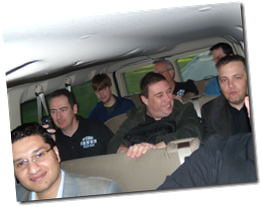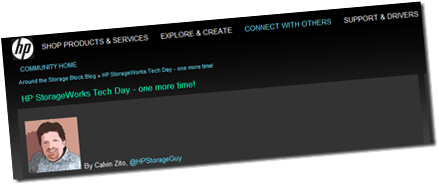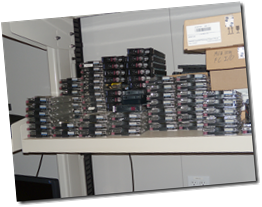Last week, I had the honor of attending an HP Tech Day event in Houston focused on their storage products. The event was a preview up and down their storage products, with diversions to related technologies (such as HP Networking).
My natural reaction is to compare these types of events to the Gestalt IT Tech Field Day series that I’ve been involved with. These are materially different in that they are univendor. In this case, HP was the sole presenter for the day and a half of sessions.
Related to HP storage technologies, there were a couple of things on this event that caught my interest:
- LTO-5 tape drives were released. I’m not the biggest fan of tape, but this evolutionary step reminds me that I need to get off tape or invest in it. I had one blog post come out on this topic.
- The dual-personality aspect of the MSA P2000 is really compelling. This can silence my critique of fibre channel (too expensive for many environments that don’t need that bandwidth) by simultaneously connecting iSCSI and fibre channel clients to the same controller.
- I liked the storage lab where we had an opportunity to see various aspects of the quality process associated with the storage products. I have a blog post going live this week or so on TechTarget’s SearchSoftwareQuality.com, I’ll Tweet it and link feed it on this site when it is online.
- The upcoming ‘over-arching’ interface or strategy for all of the storage products (mentioned below).
- Where they are going in the networking space. Make no mistake, Cisco networking has a higher per-port cost than most other products. When we see some broader standards adoption by the partner ecosystem, then I think we’ve got a chance to put to rest the old saying “No one ever got fired for buying Cisco.”
- When presented with the opportunity to ask questions to HP about specific standards-based topics for HP Networking, my favorite feature is Cisco Discovery Protocol (CDP). I live and die by CDP in VMware vSphere installations to get the port information for a specific interface in the vSphere Client. As it is now, you can only do that on Cisco networking gear with vSphere. Can HP lean on the partner ecosystem to add a standard-based protocol that provides the same helpful information? That remains to be seen, but that is what needs to happen to give HP Networking a real chance at the enterprise data center.
What I liked
- I liked the opportunity to get a better picture of the entire storage offering by HP.
- Access to people who know their stuff, both presenters and attendees. Here is a partial shot of the attendee pool (left to right: Devang Panchigar, Rodos, Brad Sams, Chris Evans, Kirby Wadsworth, Bryan and Simon Seagrave):

- The time to focus on the technology, something that myself and others may not be able to afford independently.
- The future roadmap for the HP x9000 series of enterprise NAS storage products to have de-duplication coming in the future. That’s a given in my opinion to play with the competition in that space.
What I didn’t like
- A frequent reliance on the fact that HP leads the server market. I don’t mean to knock the ProLiant series, but simply because they are the segment leader for most categories a number of natural leadership distinctions come by default. So, there were many statistics like “VMware is installed on HP hardware more than any other brand” or similar (I may even be misrepresenting this, but you get the picture).
- Lack of “teasers” to the future. To be fair, the HP crew needs to be careful about what they feed us. All the material for these events are non-NDA but may be embargoed.
- OK, somewhat jealously, but the guys in the labs had some kick-butt hardware for their testing purposes. Somewhat dreamy, all drives were SAS and there were plenty of them! Well, not all of them. Here is a shelf of ultra 320 disks (many labs had scores of SAS drives as well!):
Over-Arching Storage Offering Versus Disconnected Point Solutions
This is the biggest opportunity for HP to unify the products. Each storage solution has a different use case and core set of functionality offerings. From the MSA P2000 and P4000 series storage arrays, to the StorageWorks x9000, EVA series, and SVSP series – you get a wide and varied offering. To be fair, HP takes the best technologies available and folds them into the product line where applicable. The best example of this is the LeftHand acquisition.
What I’d like to see is a unified console or similar storage software for all products. This is due to by blossoming familiarity with NetApp storage, but is a clear difference in that each product has a different look and feel for HP storage.
More Questions Than When I Started?
To an extent, yes. But part of that is because “I am not a storage guy” as I mentioned earlier. But, this is mainly to re-evaluate what I am doing with storage in my current practice as well as what I work with in the blogosphere.
As a virtualization professional, I feel I have a good handle on virtualization and networking. Storage, on the other hand, is an area where I can grow and is critically important to a successful virtualization environment.


Posted by Calvin Zito on April 5, 2010 at 11:57 pm
Hey Rick,
Thanks so much for coming to our StorageWorks Tech Day – I’m glad you were able to come and get a closer look at HP StorageWorks. Your assessment paints a good picture of what we talked about and I’m really looking forward to when we can connect more of the dots that we left a bit vague because of the NDA issue you mentioned above.
There certainly are similarities between the Gestalt IT Tech Field Day and the HP Tech Days we’ve done – in fact Stephen Foskett had said that he got the idea of doing the Tech Field Days after he attended our StorageWorks Tech Day in October last year.
Your comparison of the HP portfolio to the single product line of NetApp is an interesting one – a couple of thoughts here:
> There are several management products for NetApp FAS, though I think those software products work across the portfolio. There’s something to be said for that.
> There’s also something to be said for having products that target the market we’re addressing with management for those products – having the same management for an XP array as a P2000 MSA probably doesn’t make sense. I think we’ll get to a common look and feel but the way we manage the low end and high end of our array portfolio is different because customers have different needs. Also, because the EVA uses vRAID, the P4000 uses Network RAID, and the P2000 MSA and XP use more traditional RAID – those require the management be different.
> Some of the bloggers (I’ll not name them as they didn’t give me permission to do that) felt that having a single OS (NetApp OnTap) across all of their portfolio was a disadvantage. I know there are NetApp lovers and NetApp haters out there so I’m not debating the merits of what they offer. I’m just pointing out that both approaches have merit.
> One of the bloggers thought NetApp is over-stating their unified (SAN and NAS) positioning. He thought that most customers are not using FAS SAN capabilities and using CIFS/NFS with FAS. I know you told me that you would use iSCSI with NetApp – again, I’m not debating the merits – just pointing out that there is a difference of opinion.
There’s a reason that there are multiple vendors out there offering storage. In the end, my goal of the StorageWorks Tech Day was to help bloggers like you understand what HP has and where were headed. I think we achieved that – would you agree?
Thanks again for attending and stay in touch,
Calvin Zito
HP StorageWorks (Organizer of the Tech Day)
Posted by rickvanover on April 6, 2010 at 8:57 am
Calvin: Thanks for sharing this. Well put.
Posted by HP MSA P2000 G3 Quick Notes « Rick Vanover's Blog on April 6, 2010 at 8:15 pm
[…] of the 2000 series products changes it’s name slightly to MSA P2000 G3. Last week, when I was at HP StorageWorks Tech Day we had a chance to go over some of the details of this updated […]
Posted by This week: Hitachi Data Systems blogger day « Rick Vanover's Blog on June 13, 2010 at 7:08 pm
[…] Tech Field Field Day 3 in Seattle this July. The other blogger event I’ve participated in was the HP StorageWorks Tech Day. I received an invitation to attend a blogger day event by Hitachi Data Systems (HDS) for […]
Posted by 10 year-end tasks for network administrators | 10 Things | TechRepublic.com on December 16, 2010 at 1:17 pm
[…] the value of the BIOS firmware update for computers, servers, and storage. In fact, when I visited HP in Houston, this was an area that caught my interest. For current products, there is effectively a daily build […]
Posted by 10 year-end tasks for network administrators | The Small Business Marketing Info on December 16, 2010 at 2:11 pm
[…] the value of the BIOS firmware update for computers, servers, and storage. In fact, when I visited HP in Houston, this was an area that caught my interest. For current products, there is effectively a daily build […]
Posted by 10 year-end tasks for network administrators | 10 Things Blog, 10件事網誌 on December 16, 2010 at 6:54 pm
[…] the value of the BIOS firmware update for computers, servers, and storage. In fact, when I visited HP in Houston, this was an area that caught my interest. For current products, there is effectively a daily build […]